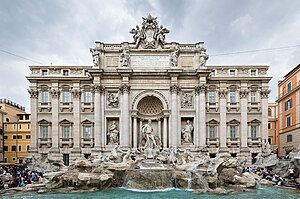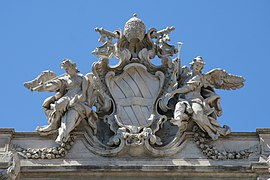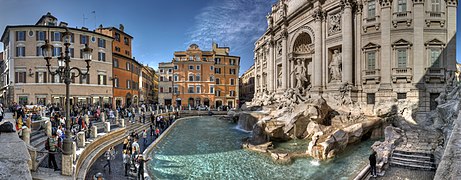Trevi Fountain
The Trevi Fountain (Italian: Fontana di Trevi) is an 18th-century fountain in the Trevi district in Rome, Italy, designed by Italian architect Nicola Salvi and completed by Giuseppe Pannini in 1762 and several others.
Standing 26.3 metres (86 ft) high and 49.15 metres (161.3 ft) wide, it is the largest Baroque fountain in the city and one of the most famous fountains in the world.
Trevi Fountain Fontana di Trevi | |
|---|---|
| Fountain | |
 | |
| Design | Nicola Salvi |
| Construction | 1732–1762 |
| Height | 26.3 metres (86 ft) |
| Length | 49 metres (161 ft) |
| Surface | Travertine stone |
| Location | Rome, Italy |
Click on the map for a fullscreen view | |
| Coordinates: 41°54′3″N 12°28′59″E / 41.90083°N 12.48306°E | |
History before 1629
The fountain, at the junction of three roads (tre vie), marks the terminal point of the "modern" Acqua Vergine—the revived Aqua Virgo, one of the aqueducts that supplied water to ancient Rome. In 19 BC, supposedly with the help of a virgin, Roman technicians located a source of pure water some 13 km (8.1 mi) from the city. (This scene is presented on the present fountain's façade.) However, the eventual indirect route of the aqueduct made its length some 22 km (14 mi). This Aqua Virgo led the water into the Baths of Agrippa. It served Rome for more than 400 years.
Name origin
The name of the fountain derives from the Latin word trivium (intersection of three streets). The statue is located right in the center of Via De' Crocicchi, Via Poli and Via Delle Muratte.
Roman aqueducts
During the sixth century, the aqueducts were not well maintained and the 14 functioning ones were damaged during the invasion of the Ostrogoths.[citation needed]
The virgin water aqueduct carries the water to the Trevi Fountain, after having collected it 10 km from the Italian capital.[citation needed]
The aqueduct is still in use today, despite some interventions during which the fountain remained empty. Calcium-free water is thought to be one of the causes[further explanation needed].
Commission, construction, and design

In 1629, Pope Urban VIII, finding the earlier fountain insufficiently dramatic, asked Gian Lorenzo Bernini to sketch possible renovations, but the project was abandoned when the Pope died. Though Bernini's project was never constructed, there are many Bernini touches in the fountain as it exists today. An early influential model by Pietro da Cortona, preserved in the Albertina, Vienna, also exists, as do various early 18th century sketches, most unsigned, as well as a project attributed to Nicola Michetti one attributed to Ferdinando Fuga and a French design by Edmé Bouchardon.
Competitions had become popular during the Baroque era to design buildings, fountains, as well as the Spanish Steps. In 1730, Pope Clement XII organized a contest in which Nicola Salvi initially lost to Alessandro Galilei – but due to the outcry in Rome over a Florentine having won, Salvi was awarded the commission anyway. Work began in 1732.

Salvi died in 1751 with his work half finished, but he had made sure a barber's unsightly sign would not spoil the ensemble, hiding it behind a sculpted vase, called by Romans the asso di coppe, the "Ace of Cups", because of its resemblance to a Tarot card. Four different sculptors were hired to complete the fountain's decorations: Pietro Bracci (whose statue of Oceanus sits in the central niche), Filippo della Valle, Giovanni Grossi, and Andrea Bergondi. Giuseppe Pannini (1718-1805), son of Giovanni Paolo Panini, was hired as architect.
The Trevi Fountain was finished in 1762 by Pannini, who substituted the present allegories for planned sculptures of Agrippa and Trivia, the Roman virgin. It was officially opened and inaugurated on 22 May by Pope Clement XIII.
The majority of the piece is made from Travertine stone, quarried near Tivoli, about 35 kilometres (22 miles) east of Rome.
Restoration
The fountain was refurbished once in 1988 to remove discoloration caused by smog, and again in 1998; the stonework was scrubbed and all cracks and other areas of deterioration were repaired by skilled artisans, and the fountain was equipped with recirculating pumps.
In January 2013, it was announced that the Italian fashion company Fendi would sponsor a 20-month, 2.2-million-euro restoration of the fountain; it was to be the most thorough restoration in the fountain's history.
Restoration work began in June 2014 and was completed in November 2015. The fountain was reopened with an official ceremony on the evening of 3 November 2015. The restoration included the installation of more than 100 LED lights to improve the nighttime illumination of the fountain.
2023 protest
On May 21, 2023, activists of the climate group Ultima Generazione (Last Generation) climate protest group vandalized the fountain by dying the water with charcoal. Rome Mayor Roberto Gualtieri criticized the attacks on heritage sites. As the fountain recirculates the water, cleaning of the fountain would need the 300,000 litres of polluted water to be emptied and replaced resulting in significant costs. Ryan Maue, the former chief scientist for the National Oceanic and Atmospheric Administration, stated the attack was done by "climate eco-anarchists".
Iconography
The backdrop for the fountain is the Palazzo Poli, given a new façade with a giant order of Corinthian pilasters that link the two main storeys. Taming of the waters is the theme of the gigantic scheme that tumbles forward, mixing water and rockwork, and filling the small square. Tritons guide Oceanus's shell chariot, taming hippocamps.
In the centre, a robustly-modelled triumphal arch is superimposed on the palazzo façade. The centre niche or exedra framing Oceanus has free-standing columns for maximal light and shade. In the niches flanking Oceanus, Abundance spills water from her urn and Salubrity holds a cup from which a snake drinks. Above, bas reliefs illustrate the Roman origin of the aqueducts.
The Tritons and horses provide symmetrical balance, with the maximum contrast in their mood and poses[citation needed] (by 1730, Rococo was already in full bloom in France and Germany).
Coin throwing
Coins are purportedly meant to be thrown using the right hand over the left shoulder. This was the theme of 1954's Three Coins in the Fountain and the Academy Award-winning song by that name which introduced the picture.
An estimated 3,000 euros are thrown into the fountain each day. In 2016, an estimated €1.4 million (US$1.5 million) was thrown into the fountain. The money has been used to subsidize a supermarket for Rome's poor; however, there are regular attempts to steal coins from the fountain, even though it is illegal to do so.
Gallery
- Trevi Fountain
- Sculptures at night
- Trevi Fountain papal coat of arms
- Trevi Fountain as viewed from the right side
In popular culture
This section needs additional citations for verification. (May 2022) |

The fountain has appeared in several films, including Roman Holiday (1953); Three Coins in the Fountain (1954); Federico Fellini's classic, La Dolce Vita (1960); Sabrina Goes to Rome (1998); and The Lizzie McGuire Movie (2003).
The Trevi Fountain is depicted in the third movement, "The Trevi Fountain at Noon", of Ottorino Respighi's 1916 symphonic poem Fountains of Rome.
In Federico Fellini's 1960 film La Dolce Vita, Anita Ekberg wades into the fountain with Marcello Mastroianni.
In 1973, the Italian national postal service dedicated a postage stamp to the Trevi Fountain.
Replica
A 11 m high and 20.6 m wide similar façade construction as monument was built in 2023 at Serra Negra, Brazil.
Another copy is located near Caesars Palace in Las Vegas, and yet another replica can be found in the Jamsil station of the Seoul Metro Subway.
See also
References
External links

- Engraving of the fountain's more modest predecessor.
- Roman Bookshelf – Trevi Fountain – Views from the 18th and 19th centuries
- Trevi Fountain Live Cam
- Trevi Fountain Virtual 360° panorama and photo gallery.
 Media related to Fontana di Trevi at Wiki Commons
Media related to Fontana di Trevi at Wiki Commons
| Preceded by Fontana delle Tartarughe | Landmarks of Rome Trevi Fountain | Succeeded by Fountain of the Tritons |
This article uses material from the Wikipedia English article Trevi Fountain, which is released under the Creative Commons Attribution-ShareAlike 3.0 license ("CC BY-SA 3.0"); additional terms may apply (view authors). Content is available under CC BY-SA 4.0 unless otherwise noted. Images, videos and audio are available under their respective licenses.
®Wikipedia is a registered trademark of the Wiki Foundation, Inc. Wiki English (DUHOCTRUNGQUOC.VN) is an independent company and has no affiliation with Wiki Foundation.



